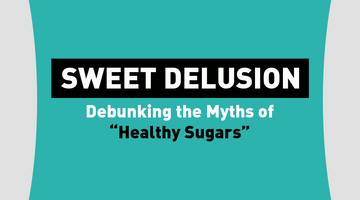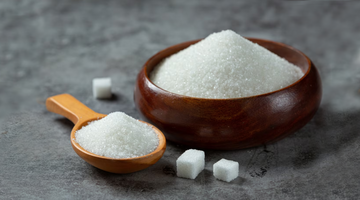WAAITT! Hold off biting on that "healthy" chocolate made with date sugar or jaggery.
Let's first crack the code and see what's hiding inside these sweet treats.
Delusion #1
Lately, everyone's been swapping regular sugar for fancy natural forms like date sugar, jaggery, brown sugar, honey, and coconut sugar.
The belief is that since these are not processed, they’re natural, right?
But here's the scoop: all these sugars require processing before they can be used in any food item. Now, if processed food is an issue, then why bother with packaged food at all?
The juicy truth is that all sugars are made up of the same building blocks called glucose and fructose. It does not matter if it's refined sugar, date sugar, jaggery, brown sugar, coconut sugar, or honey, the proportions of these building blocks are very similar.
And guess what? They all work the same way in your body, leading to sugar blues like extra pounds, tiredness, and even severe health problems like fatty liver, diabetes, and Alzheimer's disease.
These so-called natural sugars are relatively less sweet than regular sugar. This means that a higher amount of such sugars needs to be added to achieve the same level of sweetness as that of refined sugar.
Let’s take an example: Date sugar is only 60% as sweet as regular sugar. So, to get the same sweetness level, one and a half teaspoons of date sugar will be needed to replace every teaspoon of regular sugar. That's like sneaking in extra calories without us even noticing!

Delusion #2
Well, calories aside, at least these sugar alternatives have minerals that are necessary for our bodies, right?
No! Not really.
Those claims about sugars, like jaggery, date sugar and brown sugar, being mineral powerhouses are not true.
The amount of minerals in most of them is far less as compared to the calorie overload.
Some minerals found in these sources of sweetness can very easily be obtained from commonly consumed food items like lentils, milk, and nuts.
Additionally, our body can only utilize a very small percentage of the minerals consumed from plant-based sources. In the case of iron, less than 10% of iron consumed from plant-based sources can be absorbed by our body. It's like trading a sugar rush for a calorie cliff dive instead of for any actual nutrition – leaving us with ‘empty calories’ similar to those in white sugar.
Let’s delve deeper and compare the percentage of calories coming from a particular sugar with the percentage of minerals it offers:
Ignoring sugar’s other sins and solely focusing on its mineral content, it may make sense to consume the form of sugar providing a higher mineral percentage compared to its calorie percentage.
Let us examine each of the forms of sweeteners in detail on the basis of their mineral content available to the body -
Date Sugar has a higher percentage of potassium and magnesium compared to its calorie percentage. But let’s not jump to eat date sugar yet since it still will not be prudent to consume date sugar for these minerals.
The first reason for this is that potassium is widely available across our staple food items (in potatoes, lentil, and spinach) and consequently, potassium deficiency rarely occurs.
The second reason is that in the case of low magnesium levels in our body, our kidneys stop excreting magnesium to balance its level in the body, decreasing the chances of a magnesium deficiency. Nevertheless, consuming date sugar as your source of magnesium is not prudent – the amount of magnesium in just 2 almonds is more than that in a tablespoon of date sugar, without the overload of calories.
Jaggery may seem a good source of potassium, magnesium, and iron. But as discussed above, one does not need to consume jaggery for potassium and magnesium.
The amount of magnesium in 3 almonds is more than that in a tablespoon of jaggery!!
Jaggery is also not a great source of iron since only 0.7% (10% of total iron in jaggery) of iron will be absorbed from one tablespoon of jaggery – way lower than the calorie percentage of 2.3%. The wise decision would be to give jaggery a pass too!
Brown sugar has exactly the same composition as white sugar with no minerals present in significant quantities. The only difference between the white poison and brown sugar is the color which comes from the additional molasses and impurities it contains – effectively making it a brown poison.
Honey, like any other sugar, is made of glucose and fructose. Again, it fails to deliver noteworthy mineral content.
The small amounts of antioxidants present in honey don’t outweigh the large amounts of glucose and fructose they contain.
If you have been consuming honey for its antioxidants, then here is an interesting fact for you: all the antioxidants present in a teaspoon of honey are present in just half a blueberry.
Conclusion
The landscape might be different, but the impact on your body is the same when you consume any of these sugars that are perceived as healthy or natural.
Minimizing sugar consumption and sticking to whole, delicious foods is the best bet for a healthy life.
And whenever you crave a little sweetness, you've got awesome allies made from monk fruit and stevia – they're natural, calorie-free, and won't give you the sugar blues.
Remember, life's sweetness is all about balance. Your body will thank you for it!





